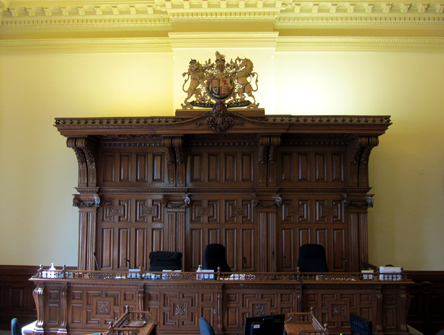The Atlantic seat: Part of Canada’s constitutional architecture?
At first, Prime Minister Trudeau’s announcement of a revamped process for appointing Supreme Court judges ticked all the right boxes.

At first, Prime Minister Trudeau’s announcement of a revamped process for appointing Supreme Court judges ticked all the right boxes. Independent advisory board? Check (and chaired by a woman, too – former Prime Minister Kim Campbell).
A less partisan, more open application process? Yes. Parliamentary scrutiny of the nominee? That too.
But what the Prime Minister’s op-ed failed to mention is that qualified lawyers and judges from across the country will be considered to replace Nova Scotia’s Justice Cromwell when he retires in September – not just applicants from the four Atlantic provinces.
This is a problem (as Nova Scotia Premier Stephen McNeil; Newfoundland and Labrador Justice Minister Andrew Parsons; and David McLaughlin, former deputy minister in the New Brunswick provincial government and former Conservative chief of staff, have all argued). It might even be a constitutional problem.
It is not written down in our Constitution Acts, or even in the Supreme Court Act, that one of the Court’s nine judges must come from Atlantic Canada (Newfoundland and Labrador has never had a judge on the Court, by the way). But that’s been the historical convention, as Emmett Macfarlane pointed out in his piece for Maclean’s.
After the Supreme Court’s opinion in the Reference re Supreme Court Act, ss. 5 and 6 (aka the “Nadon Reference”), it’s arguable that conventions about the regional composition of the Court have achieved constitutional status – that they have become part of Canada’s “constitutional architecture,” to use a phrase from the Nadon Reference (which also appears in the Reference re Senate Reform). This means the new process may be subject to legal challenge (or political consequences, at the very least).
Quebec, of course, is the only province with a guaranteed number of seats on the Court: three (see section 6 of the Supreme Court Act). The Nadon Reference dealt with the relatively narrow question of whether a judge from the Federal Court of Appeal fit the criteria for a Quebec appointee, who must come “from among the judges of the Court of Appeal or of the Superior Court of the Province of Quebec or from among the advocates of that Province.” The majority of the Supreme Court said no, making Justice Nadon ineligible.
Section 6 is an important pillar of the Court’s constitutional architecture:
The purpose of s. 6 is to ensure not only civil law training and experience on the Court, but also to ensure that Quebec’s distinct legal traditions and social values are represented on the Court, thereby enhancing the confidence of the people of Quebec in the Supreme Court as the final arbiter of their rights.
Again, there is no equivalent protection for judges from Atlantic Canada (we don’t have our own unique system of law either – although some lawyers on the ground may disagree).
But the Nadon Reference could be taken to suggest that regional representation, more generally, is also an essential — and therefore constitutionally protected — feature of the Court, one that cannot be discarded on a political whim.
The reason for that is federalism. To cite Emmett MacFarlane again, this time from Twitter: “I don’t understand why people think it’s appropriate to abandon regional representation on the SCC. This is Federalism 101.”
According to another famous reference opinion of the Supreme Court, the Reference re Secession of Quebec, federalism is one of the “fundamental and organizing principles of the Constitution.” In the Secession Reference, the Court explained federalism this way:
[43] Federalism was a legal response to the underlying political and cultural realities that existed at Confederation and continue to exist today. At Confederation, political leaders told their respective communities that the Canadian union would be able to reconcile diversity with unity. …
The federal-provincial division of powers was a legal recognition of the diversity that existed among the initial members of Confederation, and manifested a concern to accommodate that diversity within a single nation by granting significant powers to provincial governments. The Constitution Act, 1867 was an act of nation-building. It was the first step in the transition from colonies separately dependent on the Imperial Parliament for their governance to a unified and independent political state in which different peoples could resolve their disagreements and work together toward common goals and a common interest. Federalism was the political mechanism by which diversity could be reconciled with unity.
How interesting that federalism was linked to diversity.
I would argue that regional diversity on the Supreme Court – an institution we know has “constitutional status” – advances our federal project, and promotes Canadian unity. As stated in the Nadon Reference, the Court plays “a vital role as an institution forming part of the federal system” and is “central to the functioning of legal systems within each province and, more broadly, to the development of a unified and coherent Canadian legal system.” Given this role, there is value in having judges from all regions of Canada sit and work together “at the apex of the Canadian judicial system, as the court of last resort for all Canadians.”
In other words: an institution that is such a crucial component of federalism should have representation from all parts of the federation.
Nor does regional diversity foreclose other kinds of diversity. The federal government’s news release about the new process explicitly seeks candidates “representative of the diversity of our great country.”
There has never been an Indigenous judge, a judge of colour, or a LGBTQ judge on the Supreme Court. But why presume there won’t be a competent and capable nominee from Atlantic Canada who also advances the Court’s diversity of gender, race, sexuality, and / or ethnicity, especially with the new wider application process? That kind of assumption does a disservice to our region’s lawyers and judges. The essential goal of enhancing diversity on the Supreme Court can work in tandem with the need to preserve regional representation.
(Regardless, now may be the time to talk about reserving a seat on the Court for an Aboriginal judge. On a similar note, I think applicants for the SCC should be considered to meet the “functional bilingualism” requirement if they speak English or French and an Indigenous language.)
Also notable in the Nadon Reference are the Court’s remarks about preserving “institutional legitimacy” and maintaining the “status quo” of the Court’s composition. Although these comments were made specifically about maintaining Quebec’s representation, they can also apply to regional diversity more broadly. A regionally representative Court is the status quo, and renders the institution more legitimate in a federal system like ours.
Therefore, the convention of regional appointments has achieved sufficient status, and serves such a fundamental purpose, that it should not be dispensed with lightly. (It’s beyond the scope of this post to consider whether a constitutional amendment would / should be required, but note the Nadon Reference addresses the issue in the Quebec context.)
Even if the regional representation on the Court is more of a political tradition than a legal/constitutional requirement, why would Prime Minister Trudeau risk upsetting a region that gave his party every single seat in the last election? A cynic might say that most of those voters won’t notice or care; Supreme Court appointments don’t get quite the same fanfare in Canada as their American counterparts. And those of us who do care will be happily distracted if the advisory board recommends, and the Prime Minister chooses, a stellar appointee from elsewhere in Canada.
The problem is the proverbial slippery slope. If we make an exception this time around, there is no guarantee that an Atlantic nominee will be chosen for the next vacancy after Justice Cromwell’s, or the one after that. Pretty soon—and I don’t think this is just our regional inferiority complex talking—the Court would have representation from the west (and hopefully the North), from Ontario, and from Quebec, but potentially nobody from the Atlantic provinces.
We want and need a Court that reflects the Canadians it serves. But without an Atlantic seat, the Court won’t look like Canada at all.


